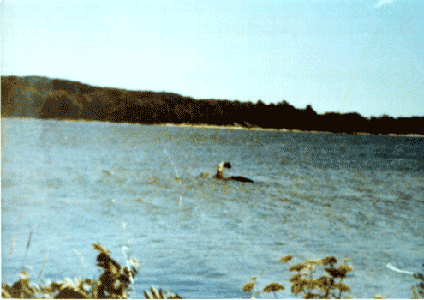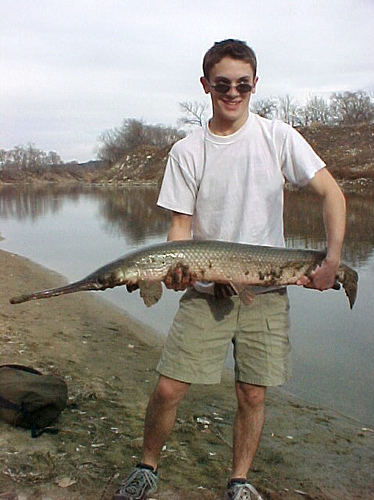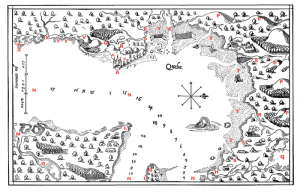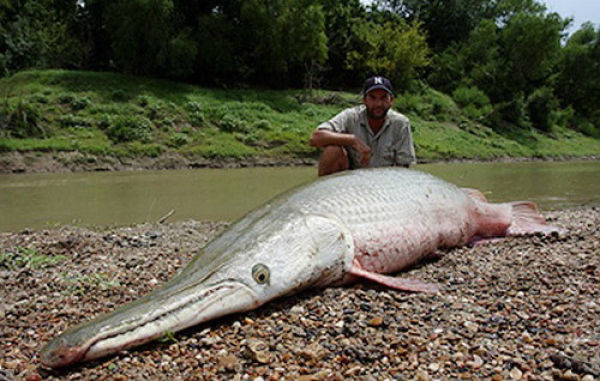April 13, 2012
Chaousarou: Champ or Not?

Acipenser fulvescens
The State of Wisconsin Department of Natural Resources has tagged a 125-year-old sturgeon (above) that is the largest on record in Wisconsin.
Officials found the 7-foot-3-inch long, 240-pound female sturgeon in the Wolf River near Shawano, earlier this week, said DNR sturgeon biologist Ron Bruch. He estimated the fish was born around 1887, when Grover Cleveland was president.
How can they tell it is 125 years old? The biologists count growth “rings” on scales, and/or ringlike structures found in otoliths (small bones of the inner ear).

Closeup of a Chaosarou?
Samuel de Champlain appears to have put the Chaosarou on his 1612 map of the lake.
This event stimulated Fortean Times editor Bob Rickard to ask: “I wonder how this compares to Champlain’s ‘Chaousarou’ which could have given rise to the legend of the Lake Champlain monster?”
I think this is a bit of retro reconstruction that is not valid. The “legend of the Lake Champlain Monster” or “Champ” appears to date from the massive settling of the area after the War of 1812. The clearing of the land, the cutting of trees, and the building of stronger fortifications around Lake Champlain created more eyewitness opportunities with the arrival of more people. (This is similar to the modern era of the Loch Ness Monsters sightings that began in 1933, when the boreal forest was cleared around Loch Ness, a road built, and thus eyewitnesses could have a look at the old Kelpies in the lake.)
 Sandra Mansi photograph, 1982, Lake Champlain.
Sandra Mansi photograph, 1982, Lake Champlain.One of the earliest published articles dates to that the colonist era around Lake Champlain. A report in the Plattsburgh Republican, dated July 24, 1819, is entitled “Cape Ann Serpent on Lake Champlain.” It gives the account of a “Capt. Crum” sighting an enormous serpentine monster.
Samuel de Champlain’s sighting of the “chaousarou” appears to have been first published in relationship to Champ in 1925, in editor Henry Percival Biggar’s The Works of Samuel de Champlain. The Champlain Society, 1925. Vol. II: 91-2. 3.
It seems to be a case of scholars finding the historical evidence after the popular cultural legend was already all the rage.
But it also seems to be an example of the square peg Champlain incident being forced into the round holes of the current, modern Lake Champlain Monster accounts. Many cryptozoologists have been very skeptical of any link between the 1602 Chaousarou tales and current Champ encounters.
Atractosteus spatula
 Lepisosteus osseus
Lepisosteus osseusDoes the Chaousarou on the map look like Sandra Mansi’s Champ photo? Is Champlain describing something else?
The 1609 account by French explorer Samuel de Champlain of his sighting of the “chaousarou” has often been discussed as having been a lake sturgeon (
Acipenser fulvescens). But one
recent paper collects the evidence Champlain’s creature may have been an alligator gar (
Atractosteus spatula), although an old favorite, as that paper notes, at 5 ft long, Champlain’s “chaousarou” he saw could have been a longnose gar (
Lepisosteus osseus), which are known to exist up to that size in Lake Champlain.
+++++++++
For the record, here is Samuel de Champlain’s words (translated into English):
The next day we entered the lake, which is of great extent, say eighty or a hundred leagues long, where I saw four fine islands, ten, twelve, and fifteen leagues long, which were formerly inhabited by the savages, like the River of the Iroquois; but they have been abandoned since the wars of the savages with one another prevail. There are also many rivers falling into the lake, bordered by many fine trees of the same kinds as those we have in France, with many vines finer than any I have seen in any other place; also many chestnut-trees on the border of this lake, which I had not seen before. There is also a great abundance of fish, of many varieties: among others, one called by the savages of the country Chaousarou [61] which varies in length, the largest being, as the people told me, eight or ten feet long. I saw some five feet long, which were as large as my thigh; the head being as big as my two fists, with a snout two feet and a half long, and a double row of very sharp and dangerous teeth. Its body is, in shape, much like that of a pike; but it is armed with scales so strong that a poniard could not pierce them. Its color is silver-gray. The extremity of its snout is like that of a swine. This fish makes war upon all others in the lakes and rivers. It also possesses remarkable dexterity, as these people informed me, which is exhibited in the following manner. When it wants to capture birds, it swims in among the rushes, or reeds, which are found on the banks of the lake in several places, where it puts its snout out of water and keeps perfectly still: so that, when the birds come and light on its snout, supposing it to be only the stump of a tree, it adroitly closes it, which it had kept ajar, and pulls the birds by the feet down under water. The savages gave me the head of one of them, of which they make great account, saying that, when they have the headache, they bleed themselves with the teeth of this fish on the spot where they suffer pain, when it suddenly passes away.
#61~ Of the meaning of chaousarou, the name given by the Indians to this fish, we have no knowledge. It is now known as the bony-scaled pike, or gar pike, Lepidosteus osseus. It is referred to by several early writers after Champlain. “I saw,” says Sagard, “in the cabin of a Montagnais Indian a certain fish, which some call Chaousarou, as big as a large pike. It was only an ordinary sized one, for many larger ones are seen, eight, nine, and ten feet long, as is said. It had a snout about a foot and a half long, of about the same shape as that of the snipe, except that the extremity is blunt and not so pointed, and of a large size in proportion to the body. It has a double row of teeth, which are very sharp and dangerous;… and the form of the body is like that of a pike, but it is armed with very stout and hard scales, of silver gray color, and difficult to be pierced.”–Sagard’s History of Canada, Bk. iii. p. 765; Laverdière. Sagard’s work was published in 1636. He had undoubtedly seen this singular fish; but his description is so nearly in the words of Champlain as to suggest that he had taken it from our author. Creuxius, in his History of Canada, published at Paris in 1664, describes this fish nearly in the words of Champlain, with an engraving sufficiently accurate for identification, but greatly wanting in scientific exactness. He adds, “It is not described by ancient authors, probably because it is only found in the Lake of the Iroquois;” that is, in Lake Champlain. From which it may be inferred that at that time it had not been discovered in other waters. By the French, he says, it is called piscis armatus. This is in evident allusion to its bony scales, in which it is protected as in a coat of mail. It is described by Dr. Kay in the Natural History of New York, Zoölogy, Part I. p 271. On Plate XLIII. Fig. 139, of the same work, the reader will observe that the head of the fish there represented strikingly resembles that of the chaousarou of Champlain as depicted on his map of 1612. The drawing by Champlain is very accurate, and clearly identifies the Gar Pike. This singular fish has been found in Lake Champlain, the river St. Lawrence, and in the northern lakes, likewise in the Mississippi River, where is to be found also a closely related species commonly called the alligator gar. In the Museum of the Boston Society of Natural History are several specimens, one of them from St. John’s River, Florida, four feet and nine inches in length, of which the head is seventeen and a half inches. If the body of those seen by Champlain was five feet, the head two and a half feet would be in about the usual proportion.
 About Loren Coleman
About Loren Coleman
Loren Coleman is one of the world’s leading cryptozoologists, some say “the” leading living cryptozoologist. Certainly, he is acknowledged as the current living American researcher and writer who has most popularized cryptozoology in the late 20th and early 21st centuries.
Starting his fieldwork and investigations in 1960, after traveling and trekking extensively in pursuit of cryptozoological mysteries, Coleman began writing to share his experiences in 1969. An honorary member of Ivan T. Sanderson’s Society for the Investigation of the Unexplained in the 1970s, Coleman has been bestowed with similar honorary memberships of the North Idaho College Cryptozoology Club in 1983, and in subsequent years, that of the British Columbia Scientific Cryptozoology Club, CryptoSafari International, and other international organizations. He was also a Life Member and Benefactor of the International Society of Cryptozoology (now-defunct).
Loren Coleman’s daily blog, as a member of the Cryptomundo Team, served as an ongoing avenue of communication for the ever-growing body of cryptozoo news from 2005 through 2013. He returned as an infrequent contributor beginning Halloween week of 2015.
Coleman is the founder in 2003, and current director of the International Cryptozoology Museum in Portland, Maine.
Email • Facebook • Twitter •
Filed under Champ/Lake Champlain Monster, Cryptomundo Exclusive, CryptoZoo News, Skeptical Discussions




 Sandra Mansi photograph, 1982, Lake Champlain.
Sandra Mansi photograph, 1982, Lake Champlain.
 Lepisosteus osseus
Lepisosteus osseus